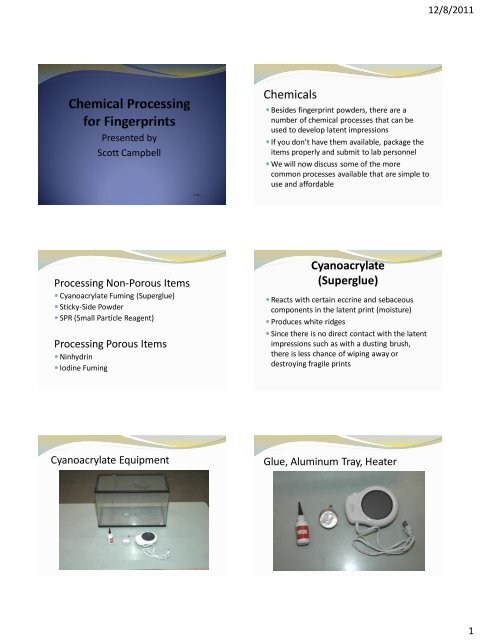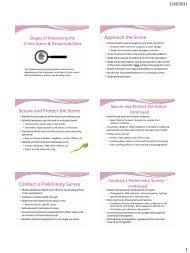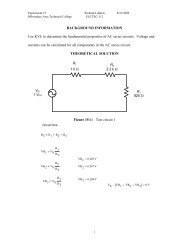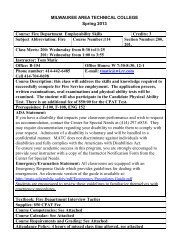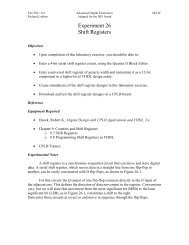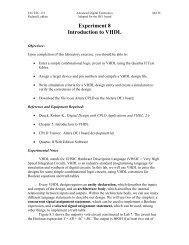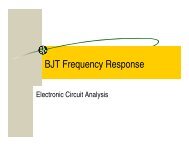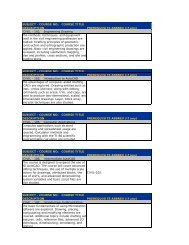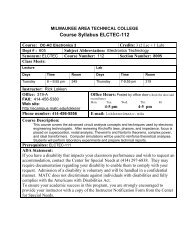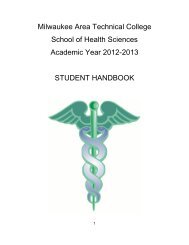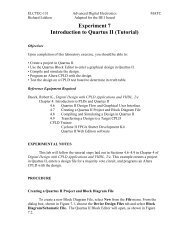Chemical Processing for Fingerprints
Chemical Processing for Fingerprints
Chemical Processing for Fingerprints
You also want an ePaper? Increase the reach of your titles
YUMPU automatically turns print PDFs into web optimized ePapers that Google loves.
Presented by<br />
Scott Campbell<br />
<strong>Processing</strong> Non-Porous Items<br />
� Cyanoacrylate Fuming (Superglue)<br />
� Sticky-Side Powder<br />
� SPR (Small Particle Reagent)<br />
<strong>Processing</strong> Porous Items<br />
� Ninhydrin<br />
� Iodine Fuming<br />
12-08-11<br />
<strong>Chemical</strong>s<br />
� Besides fingerprint powders, there are a<br />
number of chemical processes that can be<br />
used to develop latent impressions<br />
� If you don’t have them available, package the<br />
items properly and submit to lab personnel<br />
� We will now discuss some of the more<br />
common processes available that are simple to<br />
use and af<strong>for</strong>dable<br />
Cyanoacrylate<br />
(Superglue)<br />
� Reacts with certain eccrine and sebaceous<br />
components in the latent print (moisture)<br />
� Produces white ridges<br />
� Since there is no direct contact with the latent<br />
impressions such as with a dusting brush,<br />
there is less chance of wiping away or<br />
destroying fragile prints<br />
Cyanoacrylate Equipment Glue, Aluminum Tray, Heater<br />
12/8/2011<br />
1
Cyanoacrylate Fuming Chamber<br />
Items In Chamber<br />
Wet wipe container with<br />
latent impression<br />
Cyanoacrylate<br />
Non-Porous <strong>Processing</strong><br />
� Item(s) to process: Wet wipe canister<br />
� Aluminum tray <strong>for</strong> glue<br />
� Container of warm water (<strong>for</strong> added humidity)<br />
� Black lift card (test card)<br />
Black lift card (test card) with<br />
cyanoacrylate fuming completed.<br />
Close up of developed impression<br />
12/8/2011<br />
2
Preservation of Impressions<br />
� Always photograph after development<br />
� With scale and label<br />
� Fill frame<br />
� Camera parallel to surface<br />
� Follow up with chemicals and ALS<br />
or<br />
� Dust with black powder applied with a cotton<br />
ball, lift impression and attach to lift card<br />
Sticky-Side/Wet Wop<br />
Apply and allow the solution to set anywhere<br />
from a few seconds up to 60 seconds, then rinse<br />
off with a slow stream of cold water. Allow to<br />
dry, photograph, then cover with a clear sheet<br />
of acetate, or tape over with plastic fingerprint<br />
tape attaching to a lift card.<br />
Materials & Equipment<br />
Sticky-Side Powder<br />
Wet Wop & Wet Powder<br />
� All are used to process the sticky side of adhesive<br />
tapes and adhere to residue from the latents<br />
� Sticky-Side powder is mixed with a solution of 50%<br />
distilled water and 50% Photo-Flo to a consistency of<br />
thin paint, then applied with a camels hair brush<br />
� Wet Wop and Wet Powder are premixed and are<br />
applied with a camels hair brush<br />
� Wet Wop & Wet Powder are available in both black,<br />
and white colors<br />
Sticky-Side Powder Equipment<br />
� Sticky-Side Powder w/ Distilled Water &<br />
Photo-Flo<br />
� Or premixed Wet Wop<br />
� Mixing Container<br />
� Camels Hair Brush<br />
Adhesive Tapes<br />
12/8/2011<br />
3
Apply the solution with a camel’s hair brush<br />
and allow to set, up to 60 seconds.<br />
<strong>Processing</strong> Completed<br />
Preservation of Impressions<br />
� Always photograph after development<br />
� With scale and label<br />
� Fill frame<br />
� Camera parallel to surface<br />
� Allow tape to dry and attach to a clear acetate<br />
or<br />
� Attach to a lift card with clear lift tape with<br />
latent impressions face up<br />
12/8/2011<br />
4
Small Particle Reagent<br />
� Also called WetPrint. It is used primarily to<br />
process non-porous wet evidence. It adheres<br />
to the fatty substances in the latent print.<br />
Spray a light mist of the solution on the area of<br />
suspected latent impressions. After latents<br />
develop, rinse with water to remove excess<br />
solution. Photograph and lift when dry.<br />
Spray the solution on the wet item Rinse the SPR gently with water<br />
SPR (WetPrint) processing completed.<br />
Photograph, let dry and lift impression.<br />
Preservation of Impressions<br />
� Always photograph after development<br />
� With scale and label<br />
� Fill frame<br />
� Camera parallel to surface<br />
� Allow to dry and lift with fingerprint tape<br />
or<br />
� While still wet, dry area adjacent to<br />
impression, attach tape and while laying tape<br />
down, <strong>for</strong>ce the water out from under the tape<br />
12/8/2011<br />
5
Proper sequence <strong>for</strong> processing<br />
porous surfaces<br />
� Visual examination<br />
� Inherent fluorescence by laser or alternate<br />
light source (includes UV)<br />
� Powders may work if prints are fresh<br />
� Iodine fuming<br />
� Ninhydrin or DFO with light source<br />
� Physical developer<br />
Ninhydrin, squirt bottle, iron,<br />
gloves, tongs, glass dish.<br />
Drying the porous item in a<br />
ventilated hood<br />
Ninhydrin<br />
� Ninhydrin is used to develop latent<br />
impressions on porous surfaces. It reacts<br />
with the amino acids present in perspiration.<br />
Ninhydrin can be applied by spraying, dipping,<br />
or painting.<br />
� After the solution is applied, it must be dried.<br />
Then, heat and humidity (60%-80% <strong>for</strong> best<br />
results) is applied which will produce purple<br />
ridge detail.<br />
Application of liquid ninhydrin<br />
Steam Iron and Humidity Cabinet<br />
12/8/2011<br />
6
Using the steam iron to apply<br />
heat and humidity<br />
Ninhydrin processing completed<br />
Iodine Fuming<br />
� Iodine is used to develop latent impressions<br />
on porous surfaces<br />
� It reacts to oils and fatty materials present<br />
in the latent<br />
� The iodine fuming produces yellowishbrown<br />
ridge detail.<br />
Latent impressions starting to develop<br />
Preservation of Impressions<br />
� Always photograph after development<br />
� With scale and label<br />
� Fill frame<br />
� Camera parallel to surface<br />
� Latent impressions developed with chemicals<br />
have a tendency to fad after development, so<br />
quality photographs are necessary<br />
� Avoid touching the item with bare hands even<br />
after processing and keep the item inside an<br />
envelope or zip-lock bag to prevent adding<br />
additional impressions<br />
Iodine crystals and zip-lock bag<br />
12/8/2011<br />
7
Break the glass ampoule and place some of the<br />
crystals inside the zip lock bag with the evidence<br />
Iodine fuming completed<br />
Other porous surface<br />
development methods<br />
� DFO: Reacts with amino acids. Prints<br />
fluoresce with laser or alternate light source.<br />
� Physical Developer (PD): Reacts with fats and<br />
oils. Can be used to process items subjected<br />
to water.<br />
� Silver Nitrate: Reacts with the sodium chloride<br />
(salt) in perspiration.<br />
Seal the bag and shake the crystals<br />
Preservation of Impressions<br />
� Always photograph after development<br />
� With scale and label<br />
� Fill frame<br />
� Camera parallel to surface<br />
� Latent impressions developed with chemicals<br />
have a tendency to fad after development, so<br />
quality photographs are necessary<br />
� Avoid touching the item with bare hands even<br />
after processing and keep the item inside an<br />
envelope or zip-lock bag to prevent adding<br />
additional impressions<br />
12/8/2011<br />
8


